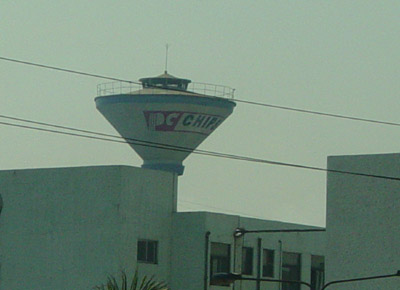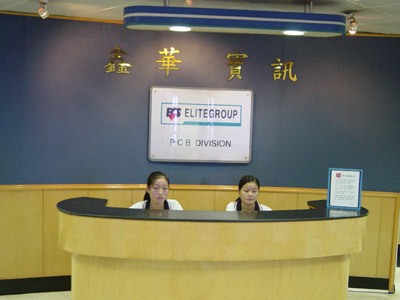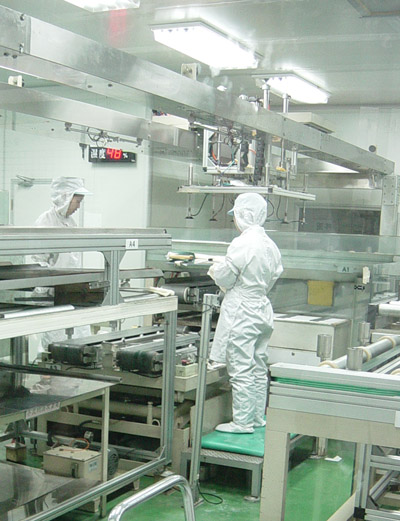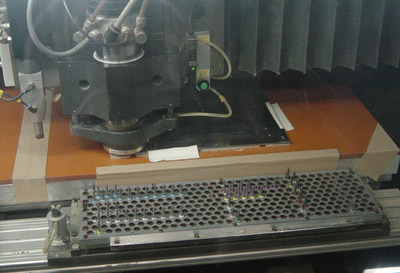Inside Elitegroup Computer Systems: From Taipei to Shen Zhen
by Kristopher Kubicki on October 4, 2003 12:39 PM EST- Posted in
- Motherboards
Biloda PCB: The Birth of a Motherboard
To say a motherboard is “born” would be the actual PCB fabrication itself. As we mentioned earlier, Elitegroup owns its own production facility in Shen Zhen off the ECSM campus. Biloda, as it is called, is one of ECS’ prized facilities. The factory itself has 1,700 workers, and like most factories in Shen Zhen, the workers live on campus in their own dormitories. Remember, Shen Zhen is a work district; so workers come from other providences in China to work even for a mere $150USD per month. Although it would never be allowed in most countries, the workforce is primarily female because studies seem to prove that females have a slightly higher concentration level than males. Accept it or not, ECS is only one of thousands of companies that employ females for manual labor.
However, that is enough about politics for now. As we pulled up to the Biloda PCB factory, it’s very apparent that this factory complex is completely different from the ECSM campus. This is one of the older facilities in the company, built in 1995. The factory chairman is the same Johnson Chiang, President and CEO of PC Chips. Thus, while touring the factory, pretty much everything seemed to have PC Chips still written on it. It is sort of a moot point since this factory is actually slated to be replaced with a newer facility capable of 300,000M2/month of motherboard PCB.
Click to enlarge.
Above, you can see two workers pressing PCB layers together. This is where the motherboard begins its long journey to becoming a final product. In this particular image, 4 layers of PCB are pressed together with insulation between each material. Obviously the more layers, the higher the signal quality of the circuitry of the motherboard. ECS has other facilities in the Biloda complex capable of 6, 8 and even some 10 layer production. You may know that PC Chips recently got into the ATI video card business, and 4 layers PCB just doesn’t cut it. Also for laptops, ECS needs to use 8 and 10 layer motherboards to keep interference down.
At this point, the board is etched for drilling. A black oxide process covers the etched elements, and then the board is finally laminated. Once it is laminated, the board looks just like a flat blank PCB.
Click to enlarge.
Next you’ll see that the pressed motherboard is moved over to the drilling factory. This is a separate building from the rest of the facility and clearly, the part of the tour where everyone goes “ooh — ahh”. Once a board has been pressed and cooled, the motherboard needs to be drilled anywhere between 5,000 to 10,000 holes in order for the circuitry to travel from the top to the bottom of the board. Furthermore, any components that need to be mounted on the motherboard itself, such as sockets or jumpers, also get drilled a hole. Right now, the motherboards are in “plates” that usually fit two separate motherboards. Thus, any process from here until the end of printing is actually working twice.
In the particular 4-layer drilling center we were in, about 40 machines drilled 6 to 12 plates at a time (12 to 24 motherboards). The process takes an hour to complete one cycle, thus generating about 500 motherboards an hour. Since Biloda works on two shifts, a daily yield in this 4-layer facility yields at least 5,000 motherboards a day, or 140,000 per month. In fact, the factory has its own technicians that just sharpen the drill bits all day, everyday!
Sharpening drill bits.
That seems like a lot for one little factory, but keep in mind that the boards have not gone through any QA yet. A majority of the boards are rejected, and also a large majority of the boards are used for different clients. ECS itself is responsible for three brands, including PC Chips, ECS and Matsonic. ECS targets PC Chips components at the entry level market, while ECS branded components are for the middle grade components. Matsonic is not terribly popular in the US, but all three brands account for enormous OEM market share (over 15% at time of publication). Furthermore, from time to time we got the occasional glimpse of Abit and Shuttle motherboards in various levels of PCB production. While one in seven motherboards might be from ECS, the chances that your motherboard came from Biloda are even higher!














30 Comments
View All Comments
Anonymous User - Monday, October 6, 2003 - link
"Quote # 19"Anonymous User - Sunday, October 5, 2003 - link
#17-Most people RMA products because they are ignorant fools who should be buying Dells.Anonymous User - Sunday, October 5, 2003 - link
Is it a misprint, or do 50% of the originally manufactured bare motherboards fail QA? If that's true, you think they could figure out what the single biggest problem there is, fix it, and drop the fail rate to 20% or something. Yeesh. This article makes it seem like a miracle that their motherboards even work at all.I was going to mention how terrible a job sticking SIMM/DIMM connectors onto motherboards, all day, every day, for $150 a month would be, but then I thought there are a lot worse ways these women could be forced to make money.
AgaBooga - Sunday, October 5, 2003 - link
Any response to #7?Anonymous User - Sunday, October 5, 2003 - link
#9 you ignorant slut...since it is impossible to get the truth about employment practices, manufacturing practices (although the article alludes to how others around ECS are polluting)or just about anything else in china your statements just show you to be an apologist for a corrupt and tyrannical system...
i can guarantee that there are no 'lazy' workers over there, a mistake or two on the line and you go back to the rice paddy and another slave takes your place - one hell of a motivator...
Anonymous User - Sunday, October 5, 2003 - link
Nice article although ECS and it's affiliates still produce some of the worst motherboards I have ever used.Anonymous User - Sunday, October 5, 2003 - link
A very interesting article.What is surprising is that it is not more mechanized and that there is so much (wo)manual labor involved!As far as the cost of labor is concerned.It may be likely that $150 is considered a good wage in ChinaAnonymous User - Sunday, October 5, 2003 - link
A very great article, I knew that ECS was a large company. But not that large and I did´nt know that they have had Matsonic and PC Chips.The article could have been much more with their mainboards and Notebooks Espacially about the QA, and production technics.
#6 ECS Produce ALOT of mainboards it is somewhat impossible to garantee a mainboard that is not defetive, or an entire shipment.
Here they article could give us some insight on what happens with RMA mainboards at ECS, this would defently provide some insight what a mainboard manufactor do with these mainboards.
#11, I agree with you.
#9, to the part of the postoffice, I can only say this. In the US the law require that a Coperate Employer also hire Minority Groups in giving %.
Anonymous User - Sunday, October 5, 2003 - link
#6, you're an idiot, stop posting.DAVIDS - Sunday, October 5, 2003 - link
#9, I think you're making a lot of over-generalizations about American workers. Lazy people can be found in every country. There are a lot of American workaholics who spend 50-60 hours/week on the job. Also, you seem to forget that many of the technological innovations found in computers were made by researchers here in the US. The microprocessor, random access memory, etc. are all American inventions.